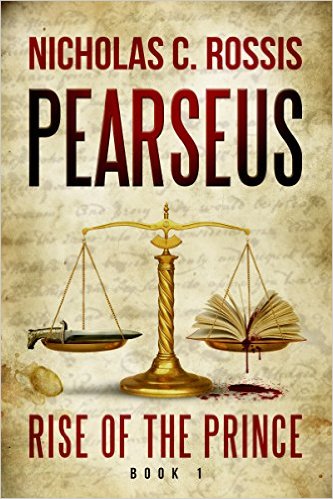Coincidentally, the two authors I first connected with when I set out to become an author both revamped the covers of their debut novels recently. I’m also in the process of re-examining my published book’s cover, so I thought it would be useful to discuss the matter further.
How does a writer’s perception on covers evolve?
Science fiction and children’s books author Nicholas Rossis and fantasy and paranoral romance author Effrosyni Moschoudi gave their novels a great boost with new, fresh, awesome covers.
Before I start the Q&A with both Effrosyni and Nicholas, note that they both have amazing offers running right now.
Effrosyni Moschoudi’s The Necklace of Goddess Athena which we will further discuss is FREE from 19-22 November.
Nicholas Rossis’ first book in the Pearseus series is FREE until November 20 and again on November 30.
Have you grabbed your copies? Now let’s talk covers.
 Effrosyni Moscoudi has received accolades for both her paranormal romance trilogy The Lady of the Pier (an Amazon Breakthrough Novel Awards quarter-finalist) and her debut time-travelling fantasy The Necklace of Goddess Athena. When the book first came out, Effrosyni had chosen this cover for it:
Effrosyni Moscoudi has received accolades for both her paranormal romance trilogy The Lady of the Pier (an Amazon Breakthrough Novel Awards quarter-finalist) and her debut time-travelling fantasy The Necklace of Goddess Athena. When the book first came out, Effrosyni had chosen this cover for it:

If you click on the book’s title above, you’ll see this new, amazing cover. Let’s ask Effrosyni about this need to give her debut a fresh look.

Hi, Fros! The new cover is awesome. Really eye-catching! But I’m sure you loved your first cover when you chose it. What were the elements you intended to bring out back then?
Well, as you know, they say you live and learn and, boy, is this the case when you’re an indie author! By the time I felt the need to give the sales on this book a boost via a new cover, I had picked up a thing or two on book covers and what makes them more appealing to the reader. They say, “don’t judge a book by its cover”, but it’s a fact that we all do. It’s human nature. So, for the new cover I knew I wanted the wow-factor to be taken under consideration more than anything else. Also, I knew the first cover was static and I needed to have a couple and an action thrown in there for a more dynamic result. I also learned at some point that colors play a very important role and that every genre has its secrets when it comes to the colors its expected to have for the genre to speak for itself. So, for The Necklace of Goddess Athena I imagined dark colors to convey mystery, danger, and to add tension – everything you would expect from a mysterious fantasy story.
And then some. How did the new cover come about?
As I mentioned earlier, I needed a new cover as to give the book a sales boost. This time round I was able to afford a professional designer specializing on e-books and I knew, more or less, what the cover should look like. My graphic designer, the talented Alex Saskalidis of 187designz was, like, in my head! I gave him the blurb and told him I wanted an antique clock and a couple on it, mentioning also the Parthenon and Athena, of course, in case he could find something suitable. Alex worked miracles with that. He came up with this awesome cover that made my jaw drop, and it was his very first proposal. It was exactly what I had in mind. He picked the dark colors without me even talking about this, and picked these incredible graphics too. The glint inside the Acropolis and the clock convey the time travel element perfectly while the couple running hand in hand were straight out of the first chapter. It’s the scene of Daphne and Phevos arriving in modern-day Athens at night. One thing I know for sure – I’m done looking for graphic designers. Alex was a breeze to work with – polite and easygoing, and that’s equally important to me. Alex was a real treasure to find and I recommend him highly!
No need to use special powers of persuasion. Your cover speaks on its own. I’m already using Alex to work his magic on my own cover.
Readers, if you think the cover is attractive wait till you delve in this book. I did and easily 5-starred it. Here’s my review.
And don’t forget. This awesome book is FREE from tomorrow until November 22! Don’t miss out! Here’s that link again: The Necklace of Goddess Athens.
 Nicholas Rossis’ rampant fantasy constructs fantastical worlds for grown-ups and imaginative tales for kids. His Pearseus epic fantasy series has reached the No. 1 spot on various Kindle categories, and Runaway Smile, his heart-warming children’s story has earned notable distinctions. You can read Runaway Smile for free on Nicholas blog.
Nicholas Rossis’ rampant fantasy constructs fantastical worlds for grown-ups and imaginative tales for kids. His Pearseus epic fantasy series has reached the No. 1 spot on various Kindle categories, and Runaway Smile, his heart-warming children’s story has earned notable distinctions. You can read Runaway Smile for free on Nicholas blog.
Nicholas, let’s talk about your Pearseus series. If I remember correctly, you created the first version of the cover, right?

Yes, and I was insanely proud of it at the time. I used a couple of designs my illustrator friend, Dimitris Fousekis, drew for me—the Pearseus logo and the scales of Themis. I hand-drew a map of Pearseus, scanned it and used it as the background, along with some paragraphs from the book in script font.
I then arranged everything to create the cover, using the best of my artistic abilities.
And why did this enthusiasm wane?
We are such terrible judges of our own work, aren’t we? That’s why we need nice people like editors and beta readers. We fall in love with our work, but can’t be sure just how great—or poor—it is until we verify it with the world.
In my case, I uploaded the covers to Rate Book Cover—a website that allows visitors to rate your books covers using a simple one-to-five star voting system. To my horror, my covers rated between 3 and 3.5 stars. That’s when I decided to have a professional designer, Alex Saskalidis of 187designz, redesign them.

I love the texture in the new cover.
Alex is great with fonts. First, he got rid of the Pearseus logo, which was intricate and impressive, but hard to read. Instead, he used a simple, modern font that hints at science fiction, thereby better conveying the unique mixture of fantasy and sci-fi of my books.
Second, he redesigned the scales of Themis, using photographs. The new scales are much more realistic and eye-catching.
Last, he used photorealistic backgrounds to create a tactile image that suits the books well.
In short, Alex’s approach was more professional than mine. You can tell he does this for a living, can’t you?
The final proof that the redesigned covers work better came when I uploaded them on Rate Book Cover. The new covers got an average score of 4.5 stars. One could argue that a difference of a single star is insignificant, but there are three reasons why I felt it was worth it:
First of all, my book covers now reflect the professional writing and editing of the books.
Second, as Pearseus has been Indie published, it has to compete against professional publishing houses. How can you do that with an amateurish cover?
And last but not least, my professional pride (fine, vanity) has now been fully satisfied. Which is priceless 🙂
Hear, hear! Alex did a great job on Pearseus as well!
Readers, make sure you grab your FREE copy of The Rise of the Prince now! Here’s the link. Yes, I’ve read and reviewed this amazing series. Here’s my review.
And if you want to see more work of the talented Alex Saskalidis, here’s his Facebook page.



















 Quanie Miller
Quanie Miller S. L. Saboviec
S. L. Saboviec

 Mike Verbickas
Mike Verbickas
 This has got to be one of the most useful articles I’ve read lately, and it’s no surprise it appeared on
This has got to be one of the most useful articles I’ve read lately, and it’s no surprise it appeared on